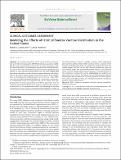Modeling the Effects of H1N1 Influenza Vaccine Distribution in the United States
Author(s)
Teytelman, Anna; Larson, Richard Charles
DownloadLarson-2012-Modeling the Effects.pdf (1.415Mb)
PUBLISHER_POLICY
Publisher Policy
Article is made available in accordance with the publisher's policy and may be subject to US copyright law. Please refer to the publisher's site for terms of use.
Terms of use
Metadata
Show full item recordAbstract
Objective
We analyzed the effects of the timing of vaccine distribution in 11 US states during the 2009 H1N1 influenza pandemic.
Methods
By using reported data on the fraction of patients presenting with flu-related symptoms, we developed a transformation that allowed estimation of the state-specific temporal flu wave curve, representing the number of new infections during each week. We also utilized data describing the weekly numbers of vaccine doses delivered and administered. By using a simple difference equations model of flu progression, we developed two influenza wave curves: first, an “observable” curve that included the beneficial effects of vaccinations, and second, an unobservable curve that depicted how the flu would have progressed with no vaccine administered. We fit the observable curve to match the estimated epidemic curve and early exponential growth associated with R0, the reproductive number. By comparing the number of infections in each scenario, we estimated the infections averted by the administration of vaccine.
Results
Southern states experienced peak infection several weeks before northern states, and most of the vaccine was delivered well after the peak of the southern flu wave. Our models suggest that the vaccine had minimal ameliorative impact in the southern states and measurable positive impact in the northern states. Vaccine delivery after peak also results in a smaller fraction of the population's seeking the vaccine.
Conclusions
Our analysis suggests that current Centers for Disease Control and Prevention policy of allocating flu vaccine over time in direct proportion to states' populations may not be best in terms of averting nationally the maximum possible number of infections.
Date issued
2011-12Department
Massachusetts Institute of Technology. Engineering Systems Division; Massachusetts Institute of Technology. Operations Research CenterJournal
Value in Health
Publisher
Elsevier
Citation
Larson, Richard C., and Anna Teytelman. “Modeling the Effects of H1N1 Influenza Vaccine Distribution in the United States.” Value in Health 15, no. 1 (January 2012): 158–166. © 2012 International Society for Pharmacoeconomics and Outcomes Research (ISPOR)
Version: Final published version
ISSN
10983015
1524-4733